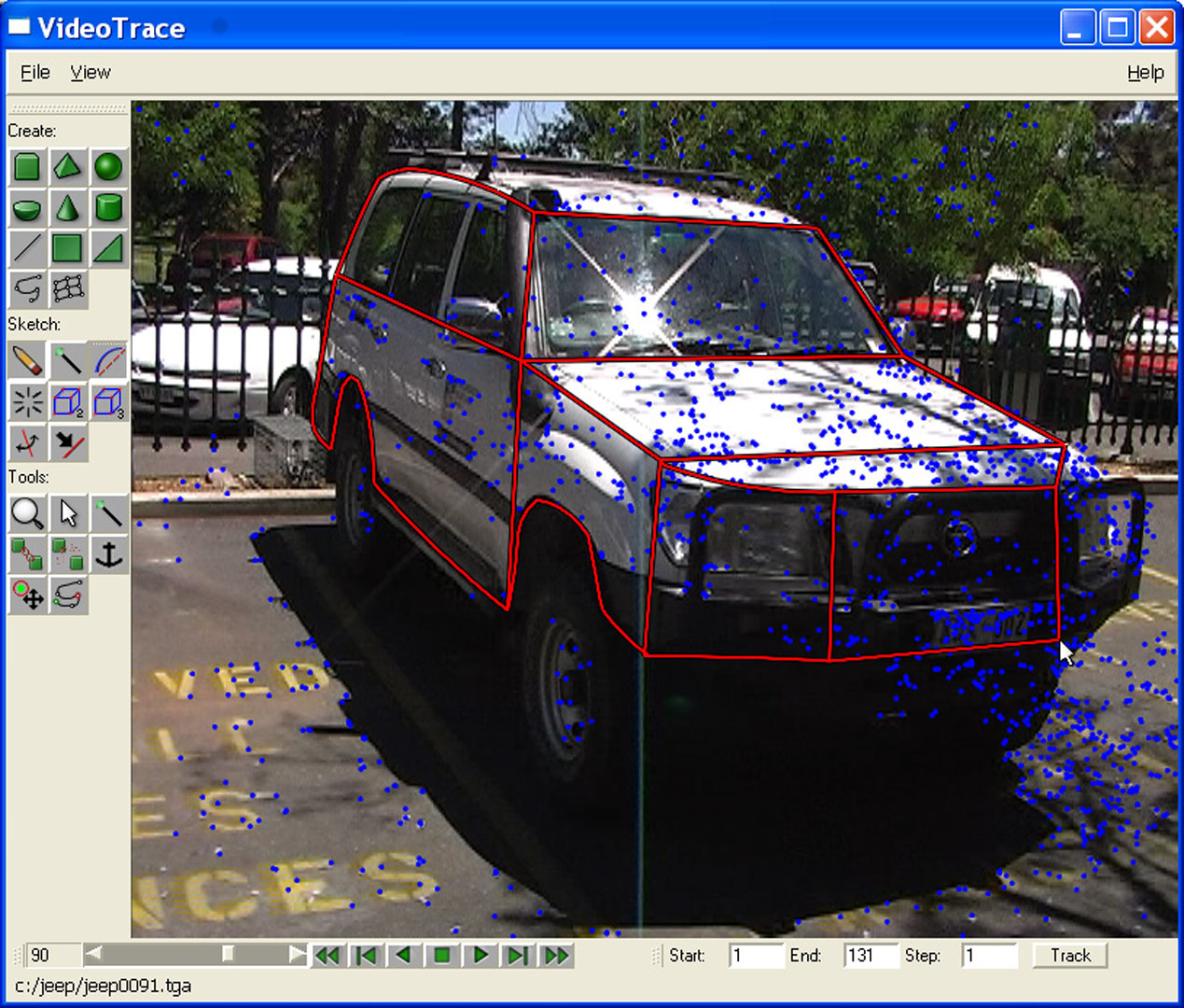“VideoTrace: rapid interactive scene modelling from video” by van den Hengel, Dick, Thormählen, Ward and Torr
Conference:
Type(s):
Title:
- VideoTrace: rapid interactive scene modelling from video
Presenter(s)/Author(s):
Abstract:
VideoTrace is a system for interactively generating realistic 3D models of objects from video—models that might be inserted into a video game, a simulation environment, or another video sequence. The user interacts with VideoTrace by tracing the shape of the object to be modelled over one or more frames of the video. By interpreting the sketch drawn by the user in light of 3D information obtained from computer vision techniques, a small number of simple 2D interactions can be used to generate a realistic 3D model. Each of the sketching operations in VideoTrace provides an intuitive and powerful means of modelling shape from video, and executes quickly enough to be used interactively. Immediate feedback allows the user to model rapidly those parts of the scene which are of interest and to the level of detail required. The combination of automated and manual reconstruction allows VideoTrace to model parts of the scene not visible, and to succeed in cases where purely automated approaches would fail.
References:
1. Agarwala, A., Hertzmann, A., Salesin, D. H., and Seitz, S. M. 2004. Keyframe-based tracking for rotoscoping and animation. ACM Trans. Graphics 23, 3, 584–591. Google ScholarDigital Library
2. Boykov, Y., and Kolmogorov, V. 2004. An experimental comparison of min-cut/max-flow algorithms for energy minimization in vision. IEEE Trans. Pattern Analysis and Machine Intelligence 26, 9, 1124–1137. Google ScholarDigital Library
3. Dick, A., Torr, P., and Cipolla, R. 2004. Modelling and interpretation of architecture from several images. International Journal of Computer Vision 60, 2 (November), 111–134. Google ScholarDigital Library
4. Eos Systems, 2005. Photomodeler: A commercial photogrammetry product http://www.photomodeler.com.Google Scholar
5. Gibson, S., Hubbold, R., Cook, J., and Howard, T. 2003. Interactive reconstruction of virtual environments from video sequences. Computers & Graphics 27, 2 (April), 293–301.Google Scholar
6. Karpenko, O. A., and Hughes, J. F. 2006. Smoothsketch: 3D free-form shapes from complex sketches. In ACM SIGGraph, Computer Graphics. Google ScholarDigital Library
7. Müller, P., Wonka, P., Haegler, S., Ulmer, A., and Gool, L. V. 2006. Procedural modeling of buildings. ACM Transactions on Graphics 25, 3, 614–623. Google ScholarDigital Library
8. Niem, W., and Broszio, H. 1995. Mapping texture from multiple camera views onto 3d-object models for computer animation. In Proc. International Workshop on Stereoscopic and Three Dimensional Imaging, 99–105.Google Scholar
9. Piegl, L., and Tiller, W. 1997. The NURBS book (2nd ed.). Springer-Verlag New York, Inc., New York, NY, USA. Google ScholarDigital Library
10. Pollefeys, M., Gool, L. V., Vergauwen, M., Verbiest, F., Cornelis, K., Tops, J., and Koch, R. 2004. Visual modeling with a hand-held camera. International Journal of Computer Vision 59, 3, 207–232. Google ScholarDigital Library
11. Quan, L., Tan, P., Zeng, G., Yuan, L., Wang, J., and Kang, S. B. 2006. Image-based plant modeling. ACM Transactions on Graphics 25, 3, 599–604. Google ScholarDigital Library
12. Ren, X., and Malik, J. 2003. Learning a classification model for segmentation. In Proc. 9th Int’l. Conf. Computer Vision, vol. 1, 10–17. Google ScholarDigital Library
13. Shpitalni, M., and Lipson, H. 1997. Classification of sketch strokes and corner detection using conic sections and adaptive clustering. Trans. of the ASME, Journal of Mechanical Design 119, 1, 131–135.Google ScholarCross Ref
14. Taylor, C., Debevec, P., and Malik, J. 1996. Modeling and rendering architecture from photographs: A hybrid geometry-and image-based approach. ACM SIGGraph, Computer Graphics, 11–20. Google ScholarDigital Library
15. Thormählen, T. 2006. Zuverlässige Schätzung der Kamerabewegung aus einer Bildfolge. PhD thesis, University of Hannover, related software ‘Voodoo Camera Tracker’ can be downloaded from http://www.digilab.uni-hannover.de.Google Scholar
16. van den Hengel, A., Dick, A., Thormahlen, T., Torr, P., and Ward, B. 2006. Building models of regular scenes from structure and motion. In Proc. 17th British Machine Vision Conference, I:197–206.Google Scholar
17. Wei, Y., Ofek, E., Quan, L., and Shum, H.-Y. 2005. Modeling hair from multiple views. In ACM SIGGraph, Computer Graphics, ACM Press, New York, NY, USA, 816–820. Google ScholarDigital Library
18. Wilczkowiak, M., Sturm, P., and Boyer, E. 2005. Using geometric constraints through parallelepipeds for calibration and 3d modeling. IEEE Trans. Pattern Analysis and Machine Intelligence 27, 2 (February), 194–207. Google ScholarDigital Library





